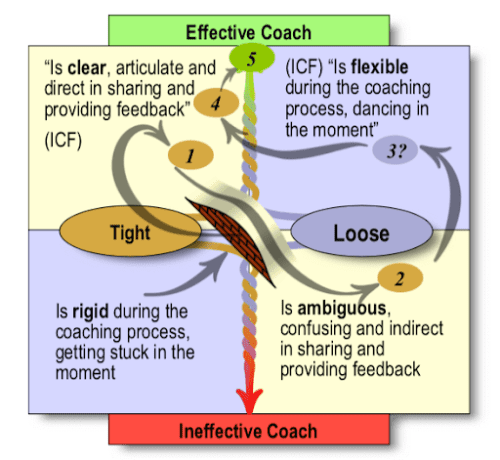For every complex problem, there is a simple solution. And it’s wrong.
Anonymous
Polarities are sets of opposites that cannot function well independently. They are interdependent, meaning you cannot choose one side as a complete “solution” and ignore the other. Going beyond Barry Johnson and coaching, polarities represent dilemmas with contradictory yet interrelated options, making decision-making complex. From seemingly trivial decisions like choosing an outfit for a date to more significant choices like career moves, the answers often lie outside the dilemma’s options, in a third path not readily apparent.
In life and coaching, polarities manifest as competing values, needs, or perspectives, forming pairs of opposing but interrelated elements in dynamic equilibrium. Unlike problems with solutions, polarities cannot be resolved. Instead, they must be managed and balanced. Failing to recognize and manage polarities can lead to frustration, stagnation, and missed opportunities for growth. Let’s explore how polarities emerge in various contexts.
Examples
One common coaching polarity revolves around Work-Life Balance, which has become even more complex in today’s work-from-home era, involving the dilemma of home, office, or hybrid work arrangements.
Another prevalent workplace polarity is the choice between a strict, results-driven approach to management and a more people-centric, nurturing approach. In reality, not every leader can embody all coaching competencies. A leader’s primary role is to deliver results, which doesn’t always align with a coaching approach.
In teamwork, the tension between independence and collaboration often surfaces. While independent autonomy can seem ideal, siloed companies may suffer due to toxic competition, hindering collaboration at the leadership level.

Managing Polarities
To address and manage polarities, consider these factors:
Intent: Define the objective and its significance. What challenges are posed by the dilemmas faced?
Recognition: Acknowledge unresolved dilemmas and the fear of conflict and disharmony.
Explore: Map polarities as an image, highlighting the benefits and drawbacks of each.
Awareness: Recognize that polarities can be balanced with a third truth that satisfies both options and objectives, requiring open-hearted empathy.
Action: Embrace the third truth and act with courage, knowing that some may not fully agree.
Case Study: C-Suite Leadership Team Resolves Collaboration Dilemma
Let’s look at a case that came up in my teamwork with a C-Suite leadership team. The team faced the dilemma of maintaining collaboration between leaders and their workforce after the leaders were moved to faraway locations. The problem had been unresolved for years and was cited as an example of the team culture of indecisiveness.
The team recognized the magnitude of the problem in terms of the cost of long-distance travel and poor decision-making. They also realized the intangible results of inadequate presence and communication between leaders and the workforce.
The team mapped out the polarities of retaining the C-Suite floor versus shifting the leaders to workforce locations, and they explored the benefits and risks of each option. After a day of intense discussion, the team moved the business leaders to their workforce locations and shifted some other leaders to their respective floors in the head office building.
Over the next two weeks, the team deliberated with their teams and added video communication devices to a meeting room. They also addressed several other issues that had been pending action for years, including better business and staff leader collaboration through formal service level agreements, technological inputs to enhanced internal and external communication, and a leadership development process across the company.
These issues were unrelated to the C-Suite location issue, but the C-Suite issue sparked open and honest discussions, sometimes heated, about the team’s hesitation to address and resolve difficult dilemmas. Using polarities in one dilemma helped resolve multiple others arising from the behavioral problem of sweeping problems under the carpet in the interest of spurious harmony.
If you’ve found the concept of polarities intriguing, our programs will empower you to harness the power of balance in your coaching practice. Visit our website to explore the wide range of upcoming programs that will help you become a more effective and insightful coach. Join us in the journey of self-discovery and transformation!”
Originally published on Coaching the Spirit, a LinkedIn Newsletter by Ram S. Ramanathan: https://www.linkedin.com/pulse/how-use-polarities-resolve-dilemmas-ram-s-ramanathan-mcc/?trackingId=QdyyZ319TIa%2F8sC%2FjTky6A%3D%3D
Photo by Samuel Chenard on Unsplash



